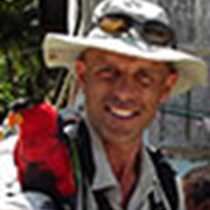Bjornoya
After so many calm and clear days, eventually the weather had to take a turn for the worse – it could hardly get any better. Today at Bjornoya we began to feel as if we have finally arrived in the Arctic. The skies were low and grey – low enough that the tops of the sea cliffs of Bjornoya were shrouded in mist. And a chill wind was blowing. Fortunately, neither development was enough to prevent us from enjoying a full day at this remote island.
An afternoon hike onshore gave us our first encounter with high Arctic tundra and the diverse community of flowering plants that can be found in this apparently inhospitable landscape. The bright colours of the Arctic flora - from the pale creams and yellows of Arctic poppies to the bright patches of purple saxifrage - were a surprise in the tundra landscape.
Before this, a morning Zodiac cruise along the spectacular coastline allowed us to get up close and personal to both the multitudes of seabirds that inhabit the island and the remarkable geology that gives rise to 1,000 foot sheer cliffs and dramatic sea caves such as the famous ‘Pearly Gates’ – a narrow sea tunnel through which a willing driver can navigate a Zodiac. We also encountered the wreck of the Petrozavodsk, a cargo ship which ended up on the rocks at the southern tip of Bjornoya last month.
This wreck is a clear demonstration of how vulnerable seabird populations can be to apparently minor events. Historically, shipwrecks have delivered unwanted alien species such as rats to islands where they have killed ground-nesting birds which evolved in isolation from mammalian predators. More recent shipwrecks have unleashed oil spills with disastrous impacts on seabird populations. Fortunately, on this occasion, neither scenario seems to be an issue, through luck rather than judgment.
As we continue our journey north, we anticipate seeing our first sea ice tomorrow morning and Spitsbergen soon thereafter. Who knows what else tomorrow may bring?




